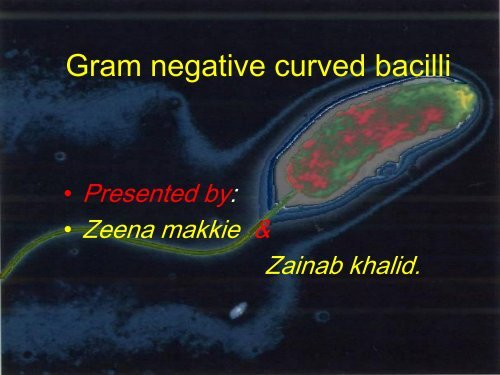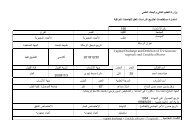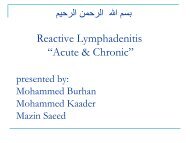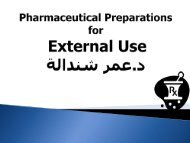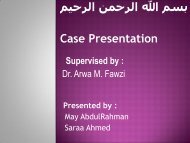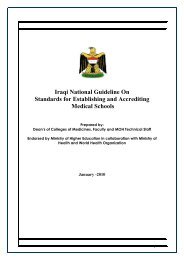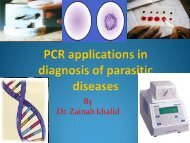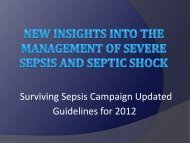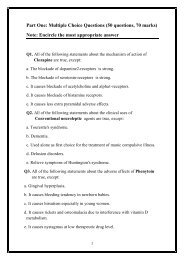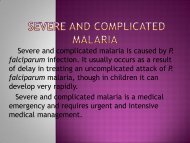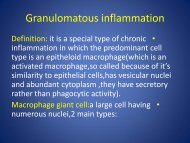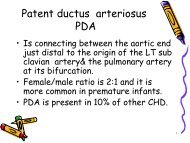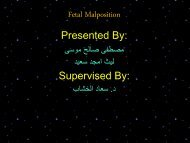Create successful ePaper yourself
Turn your PDF publications into a flip-book with our unique Google optimized e-Paper software.
Gram negative curved bacilli<br />
• Presented by:<br />
• Zeena makkie &<br />
Zainab khalid.
Gram negative curved bacilli<br />
• There are certain M.O that share this type of<br />
morphology which is sometimes described as<br />
coma-shaped<br />
• The following M.O are gram negative curved<br />
bacilli:<br />
1. <strong>Vibrio</strong>.<br />
2. Aeromonas.<br />
3. Plesiomonas.<br />
4. Campylobacter.<br />
5. Helicobacter.
General charectarestics:<br />
• Gram negative curved bacilli.<br />
• Motile by a single polar flagellum.<br />
• Live in fresh water &sea water.<br />
• It can cause diarrhoea in human.
Family: vibrinaceae<br />
genus :vibrio<br />
Genus vibrio is classified 10 important<br />
species:<br />
1.<strong>Vibrio</strong> <strong>cholerae</strong>:it can cause epedic<br />
&pandemic cholera.<br />
2.Non cholera vibrios:it can cause<br />
ear,wound,soft tissue infection&extra<br />
intestinal infections
• The most important species are:<br />
V.mimicus, V .vulnificus, V .hollisae, V<br />
.fluvialis,V.damesla,V. frunissi,V.<br />
alginolyticus,V. metschnikovii.<br />
3. V.parahaemolyticus:Causes<br />
gastroenteritis,&extrintestinal infections.
• John Snow (1813-<br />
1858):<br />
• Water borne<br />
transmission of<br />
Cholera (1855)<br />
Causative Agent<br />
Discovery
• Filippo Pacini (1812-<br />
1883)<br />
– 1854: Cholera reaches<br />
Florence, Italy. Pacini<br />
discovers causative agent<br />
– Publishes “Microscopical<br />
Observations and<br />
Pathological Deductions on<br />
Cholera”<br />
– 1965: Bacterium named<br />
<strong>Vibrio</strong> <strong>cholerae</strong> Pacini 1854<br />
Discovery
• Robert Koch (1843-<br />
1910)<br />
• 1884: Rediscovers<br />
<strong>Vibrio</strong> <strong>cholerae</strong><br />
Discovery
<strong>Vibrio</strong> <strong>cholerae</strong><br />
• Have 2 imp antigens;H(shared)&O spesific which<br />
is LPS.<br />
• There are at least 139 O-antigen groups.<br />
• Only of O group 1(o1)&139(o139) cause classical<br />
cholera disease.<br />
• While non O1-O139 can cause cholera like<br />
disease<br />
• Both o1-o139 of 2 bio type:<br />
1. Classical .<br />
2. El-Tor.
Both bio types can be sub grouped into<br />
3 biotypes:
Differentiation between classical<br />
and EL-TOr biotypes of V.cholera<br />
tests<br />
Voges-proskauer<br />
Chicken RBC<br />
agglutination<br />
Polymyxin-B<br />
sensitivity (50 U)<br />
Group IV choleraphage<br />
sensitivity<br />
Bet-haemolysis (on<br />
blood agar)<br />
classical<br />
_<br />
_<br />
+<br />
+<br />
_<br />
EL-Tor<br />
+<br />
+<br />
_<br />
_<br />
+
<strong>Vibrio</strong> cholrae(O-1&O139)<br />
• These m.o are highly aerobic.<br />
• Very actevly motile (described as<br />
darting(shooting) motility.<br />
• The best way to detect motility is by dark<br />
feiled microscopy or contrast microscopy.<br />
• After prolonged culture these m.o become<br />
straight .<br />
• Can tolerate temp. of range 18-37.
Biochemical characteristics of<br />
V. <strong>cholerae</strong>:<br />
• They ferment glucose,maltose&succarose.<br />
with acid production only.<br />
• Oxidase +ve &catalase +ve.<br />
• Give ve cholera red reaction on nitrate<br />
pepton media by reducing nitrate to nitrite.<br />
• Indol test +ve on tryptophan media when<br />
the lator 2 test are combined red coulor<br />
also appear due to nitroso-indol when<br />
H2SO4 is added.
• TSI is A/A.<br />
• The optemal ph of growth is 7 but they can<br />
tolerate up to 8,5-9.<br />
• They are sensitive to acidic PH less than 6<br />
so they are quite suseptable to gastric<br />
juice.<br />
• V.<strong>cholerae</strong> o-139 is like El-Tor but it<br />
differs by being capsulated.
Culture of V. <strong>cholerae</strong><br />
1. Alkaline peptone water media:<br />
PH of this media is 8.5-9 .<br />
Used for primary cultivation from clinical<br />
specimens.<br />
Growth on it can be detected as a surface<br />
pellicle within 8 h.<br />
Sub culture on solid media .
2. Thiosulfate Citerate Bile salt<br />
Sucrose agar (TCBS)<br />
• TCBS is the medium of choice for the isolation of V.<br />
<strong>cholerae</strong>.<br />
• easy to prepare, requires no autoclaving .<br />
• it has a relatively short shelf life once prepared (3 to 5<br />
days) unless plates are carefully protected against<br />
drying.<br />
• The non –inoculated m.o is olive green.<br />
• bromo thymol blue is the indicator.<br />
• V.<strong>cholerae</strong> is sucrose – fermenter.<br />
• Asid production drop the ph & change colour to yellow.
Overnight colonies of V. <strong>cholerae</strong> on TCBS agar are<br />
large (2-4 mm) and yellow because of the fermentation<br />
of sucrose. They are characteristically round, smooth,<br />
glistening, and slightly flattened.
3- Tullerite Taurochelate Gelatine<br />
Agar(TTGA)<br />
TTGA is a selective and differential agar specific for the<br />
isolation of V. <strong>cholerae</strong> .<br />
has a relatively long shelf life after preparation.<br />
overnight colonies of V. <strong>cholerae</strong> on TTGA tend to be<br />
smaller (1 to 2 mm) than those from the TCBS agar.<br />
Potassium tellurite, which is added to the medium to<br />
increase selectivity .<br />
Overnight growth of V. <strong>cholerae</strong> on TTGA agar appears<br />
as small opaque colonies with slightly dark centers<br />
opaque zone around colonies which resembles a halo,<br />
which is due to the production of the enzyme gelatinase,<br />
can be intensified by brief (15- to 30-minute) refrigeration<br />
of the plate
TTGA
4. Meat extract agar.<br />
• The colonies appear translucent green to<br />
red pronzy in colour.<br />
• On old culture the colonies appearopaque<br />
&rough
5. Taurocholate pepton broth<br />
• This media can be used for primary<br />
cultivation .<br />
• Sub cultured on other medias can be<br />
done.
6. MacConkey s agar.<br />
• They are non – lactose fermenters.<br />
• Overnight colonies of V. <strong>cholerae</strong> on MAC<br />
tend to be small to moderately sized (1 to<br />
3 mm) and usually appear as lactosenegative<br />
.
MacConkey agar
Blood agar.<br />
• El-tor growth show beta haemolysis
Practical procedure of cultevation<br />
of V. <strong>cholerae</strong><br />
1. direct stool examenation:<br />
• motility: dark field microscopy.<br />
• Microscopical<br />
examination:mucous,epith.,cells& large<br />
numbers of m.o,but no pus cells are<br />
seen.<br />
• Fluresent antibody staining
• 2 ml of faeses + 20 ml APW ph 8-8.5 are<br />
incubated for 5 h.<br />
• At the same time the TCBS is heavily<br />
inoculated & left overnight.<br />
3. From the TCBS,APW,an another APW<br />
are inoculated & left 5 h.
Furtheer identification of V.<br />
1. string test:<br />
<strong>cholerae</strong>:<br />
• a drop of 0.5% Na-deoxycholate is mixed<br />
with a colony after 60 seconds with aloop<br />
there will be a thread of tenacious like<br />
nature it is +ve test for V.<strong>cholerae</strong>.<br />
2. Poly valent antisera(anti O1,anti O139):<br />
agglutination test with specific<br />
antisera&emulsified colonies is carried<br />
out to .
String test
3. Biochemical test :<br />
• including cholera red reaction.<br />
4. Serotyping by specific antisera against<br />
A,B antigenic factors to determine<br />
Ogawa,Inaba&Hikojima.
FACTORS OF PATHOGENISITY<br />
1. Adherance &motility:<br />
the actively motile m.o can adher to the<br />
the intestinal wall(pathogenic)& visaversa<br />
for the non motile(non pathogenic).<br />
V.<strong>cholerae</strong> dose not usually reach to the<br />
blood stream.
• 2. Enterotoxine :<br />
it has amolecular wt.of 84ooo daltons.<br />
it is composed of 6 light chains of 8000<br />
each,&one heavy chain of 28000 daltons<br />
which has 2 portions:<br />
A-toxic portion(A1):98% protein,1%lipid<br />
1%CHO<br />
B-stabilizer portion(A2)
Cholera toxine
• The A1portion increase the intracellular<br />
cAMPof the intestinal epithelium.<br />
• The cAMP prevents reabsorption of Na<br />
ion, excretion of NaHCO3,Cl&K ions.<br />
• This lead to accumulation of water in large<br />
quantities(>20 liters/day),acidosis<br />
,hypokalemia& death.
thanks


